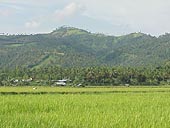|
| Baao, Camarines Sur, Philippines | |
|
When opposition leader, Benigno Aquino, was assassinated in 1983, investor confidence in the Philippine government and economy fell to all-time low. Economic growth was zero to negative. The Baao economy suffered likewise. But the resiliency of Baaoeños against all odds stands strong. As the Chinese are wont to say, "One man's adversity is another man's opportunity." In fact, the twilight years of Marcos dictatorship saw another pioneering agricultural industry being established in Baao. As the technology for freshwater aquaculture became available, the need for large numbers of tilapia fingerlings and fry rose. Agri-businessmen from Baao started to establish tilapia hatcheries in ponds that were once rice paddies. Now, the industry has grown to an extent that the town is the major supplier of tilapia fry and fingerlings to fish cage operators in Lakes Bato and Buhi in Camarines Sur. They also supply some of the needs of the operators in Laguna de Bay in Laguna and Lake Taal in Batangas. The Post EDSA Revolt The overthrow of Marcos during the EDSA revolt put the Philippine economy back into track. Slowly the investors gained confidence in the government institutions to steer the nation and ultimately the town of Baao into the next millenium. But enormous challenges await the Baaoeños in their struggle to attain a development that is sustainable and democratic. Its population is growing fast while its territory is not expanding. Pollution sources are multiplying. Its ravaged uplands and lowlands need rehabilitation. Agricultural productivity needs boosting. Its people needing awareness and skills on how to wisely use its resources out of need not of greed.
|
|
|
|



